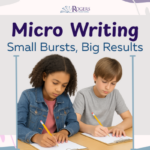** Contact us if you would like Rogers Education Consulting to bring an engaging, hands-on Readers’ Workshop or Guided Reading session to your campus **
 One thing we all know as reading teachers is that students need time to read. Students must be practicing the act of reading consistently, with things they want to read, in order to become more proficient readers.
One thing we all know as reading teachers is that students need time to read. Students must be practicing the act of reading consistently, with things they want to read, in order to become more proficient readers.
How much time should students read every day? Depending on what research you read, the recommended amount of daily reading time varies, however, but my rule of thumb is about 20 minutes a day. I know that it is difficult to carve this time out of your daily instruction, but we have to remember that if students don’t have the opportunity to practice the skills and strategies we’re teaching, they won’t improve in those areas.
Not only is it hard to find the time for students to read during the instructional day, it’s also a challenge to make sure students are on task and actively engaging in the reading process. While nothing is guaranteed, here are a few instructional ideas to put in place that will help you feel confident in prioritizing 20 minutes of independent reading time in your class.
- Student controlled choice. Yes, controlled. It is so important that students have the opportunity to choose what text they want to read. “The research base on student-selected reading is robust and conclusive: Students read more, understand more, and are more likely to continue reading when they have the opportunity to choose what they read” (Allington and Gabriel, 2012). This choice, however, shouldn’t be completely open-ended. Choice provides interest, motivation, autonomy, which will help keep students on task, but many times students need help focusing and we can provide boundaries within which students can make their choices. Some ways to limit choices are:
- Genre. Perhaps you are in the middle of a biography unit. If this is the case, then students can choose what to read, as long as it is a biography. It is okay to limit the students choice based on the genre you are currently teaching!
- Level. Sometimes students will gravitate towards books that are super easy for them or super difficult. While this is okay to do
 every now and then, we want students to be in “just-right books” for most of their reading time. I like to set up an “Agreement Contract” with the students to negotiate in this area. In the contract, it states that if they read a “just-right book,” their next book can be one that is at a different reading level. For example, take the student who only wants to read the Big Nate books, which are fun, but way below his reading level. If this student challenges himself with a book at his independent or instructional level, the contract states that he can then read a Big Nate book as a “reward.”
every now and then, we want students to be in “just-right books” for most of their reading time. I like to set up an “Agreement Contract” with the students to negotiate in this area. In the contract, it states that if they read a “just-right book,” their next book can be one that is at a different reading level. For example, take the student who only wants to read the Big Nate books, which are fun, but way below his reading level. If this student challenges himself with a book at his independent or instructional level, the contract states that he can then read a Big Nate book as a “reward.” - Author. If you are in the middle of an author study, ask students to choose books by that author, or a similar author so they can compare and contrast his/her works with those from the author of study.
- Teacher’s Collection. As the teacher, you can decide what to include in the students’ choices! Create a set of four or five books that work with what you’re teaching, maybe the topic, maybe the genre, maybe just five books you think are great and want them to read! For example, I recently taught students about hurricanes during social studies. So, during reading time, students were offered five different texts about natural disasters and they were asked to choose one.
- Accountability. Many moons ago, teachers were told to implement Drop Everything And Read (DEAR) time, Sustained Silent Reading (SSR) time, or something similar. The premise is sound; we know independent reading is vital to student reading success, so we provide time to do it. Unfortunately, many studies have since shown that these programs were not actually as beneficial for students as we thought, and many researchers agree that it was because there wasn’t any accountability. Without accountability, even the best students might not engage in the activity of reading. The tricky part here is to hold students accountable without ruining the reading experience. It is important that independent reading doesn’t turn into an activity or dreaded assignment. Students will learn to hate reading if they have to complete a packet, worksheet, or ten question quiz when they’re done! Instead, simply ask students to respond. There are a few ways you can have students respond to what they have read:
- Apply a strategy or skill. If you have just taught students how to make, confirm, and adjust predictions as they read, request they put it into practice during their independent reading. Only request enough application to hold them accountable, but not so much that it becomes a “dreaded activity.” In the past, I have found one or two applications of a skill to be the sweet spot. I would ask my students to make a prediction about what will happen next in their reading. I ask them to write that down in their journal. About five minutes prior to the end of reading, I ask students (if they haven’t already), to confirm or adjust their prediction in writing. As they confirm or adjust this prediction, they must use text evidence as support. Even though they only made one prediction, it is enough for me to know they were actively engaged in their reading and trying the strategy that was taught.
- Open response. At the end of reading time, have students reflect on their reading in their journal. This can be set up many different ways. You can ask students to respond to something that surprised them, made them laugh, or a part they liked best. Or it can be more structured, asking students to specifically describe the character’s feeling and emotions, with text evidence.

- Teacher-Student Conferences. While students are reading, the teacher should be actively teaching! This is the best time to meet with students and teach them EXACTLY what they need to move to the next step in their reading. Go to the student and ask them about what they are reading. Engage the student in conversation about the text, ask them questions that require them to show you where that happened in the text, have them read aloud to you a bit. This conversation will spark their interest in reading more by making it more of a social activity and it will provide you time to monitor and push their thinking and use of reading strategies.
What do you do to make sure students are actively immersed in reading?
_________________________________________________________________________________________________
Allington, R., & Gabriel, R. (2012). Every child, every day. Educational Leadership. q, 69(6), 10-15.



We are starting a novel study, how can I increase engagement for silent reading?
Honestly, it depends on individual students. However, in general, students will feed off of your enthusiasm. It is important to chunk text for reluctant students, to make it more manageable. Introduce choice and interesting texts.